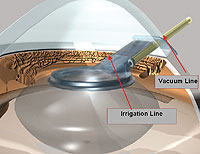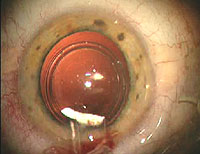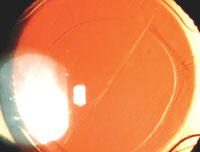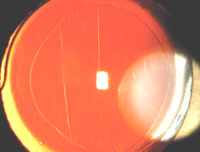Sealed capsule irrigation effective against opacification, study shows
A vacuum-sealed device maintains the irrigation within the capsular bag, preventing leakage on the surrounding tissue.
![Gerd Auffarth, MD [photo]](/~/media/images/news/print/ocular-surgery-news-europe-asia-edition/2006/04_april/auffarth_70_90_6145.jpg) Gerd Auffarth |
LISBON – Sealed capsule irrigation using a special vacuum-sealed device is safe and appears to significantly decrease the rate of posterior capsular opacification 1 year after cataract surgery, according to a study.
“The creation of a vacuum-sealed compartment over the capsular bag allows for selective application of pharmacological agents without damaging the surrounding tissue. We have experimented with irrigation with simple sterile distilled water, but other more aggressive agents that might prevent lens epithelial cell proliferation can be used,” Gerd Auffarth, MD, said at the annual meeting of the European Society of Cataract and Refractive Surgeons.
PCO still a problem
The incidence of PCO, Dr. Auffarth said, has decreased significantly in the past few years because of improvements in surgical techniques and IOL materials and design.
“The PCO rate was 25% to 50% between the 1980s and 1990s, and it is around 10% now, but we have not yet achieved 0%,” he noted.
The standard treatment, Nd:YAG laser capsulotomy, still has some long-term complications, including the possibility of IOP elevation; retinal detachment; cystoid macular edema; lens dislocation; tilt or damage; and uveitis.
“There are also costs involved, which may become an increasing burden for the health care systems due to the growing volume of cataract surgery procedures expected in future years,” Dr. Auffarth said.
Various pharmacological agents for preventing PCO have been tried in the past 2 decades. However, difficulties with finding the right dosage, evaluating the duration of exposure and preventing complications have often discouraged the routine usage of these drugs.
“The main problem is that of selectively targeting the lens epithelial cells without damaging the delicate surrounding tissue,” Dr. Auffarth said.
|
|
Images: Auffarth G |
Capsule-sealing device
About 3 years ago, Anthony Maloof, MD, introduced the Perfect Capsule system (Milvella, Australia) for sealed capsule irrigation. The device vacuum-seals the capsular bag, creating an isolated compartment in which liquid agents can be introduced without leaking on the surrounding tissue.
“After you have removed the lens nucleus, the device is plugged onto the empty capsular bag over the capsulorrhexis opening, then vacuum is applied to seal it on the capsule. The irrigation fluid is then introduced through the device’s irrigation line and flows out at the opposite end,” Dr. Auffarth said.
The feasibility and safety of the device have been shown in previous studies, he said. Recently, a prospective, randomized clinical study has been carried out to test the efficacy of sealed capsule irrigation with sterile distilled water.
Cataract surgery was performed in both eyes of 17 patients. In one eye a 2-minute irrigation using the Perfect Capsule device was performed before IOL implantation, while no sealed capsule irrigation treatment was carried out in the fellow eye. The procedure was performed under topical anesthesia, and all eyes were implanted with a Rayner Centerflex 570H IOL.
“They are hydrophilic acrylic lenses with a square edge but not around 360°. They are therefore not perfectly equipped for PCO prevention,” Dr. Auffarth noted.
He said that the sealed capsule irrigation treatment is easy to perform after a short amount of training. The only special requirements are a capsulorrhexis smaller than 5 mm and a pupil size of at least 6 mm.
|
|
Lower PCO rate
Successful vacuum seal was obtained in 14 of the 17 cases. Follow-up examinations were performed at 1 day, 1, 3 and 6 months, and 1 and 2 years. Refraction, visual acuity and IOP were measured at each visit. Biomicroscopy of the anterior and posterior segments was performed. IOL position and PCO were checked. Safety was evaluated by corneal pachymetry and endothelial cell count.
“Visual results of the treated and untreated eyes were comparable. The endothelial cell count didn’t show significant differences, with an identical development of cells in both groups. Pachymetry results were also comparable. Only a slightly lesser swelling was noticed in the corneas that were treated with irrigation,” Dr. Auffarth said.
PCO was evaluated with the EPCO 2000 image analysis program in the total IOL optic area, in the central 3-mm zone and around the capsulorrhexis margin.
“In the first follow-up visits, up to 6 months, there was absolutely no difference between the two groups of eyes. However, while in the sealed capsule irrigation group no variation was seen up to 1 year, some PCO started to develop in the other group over the second semester. These changes are still under observation, and we expect that the difference between the two groups of eyes will become even greater after 2 to 3 years,” he said.
Distilled water is non-toxic, so it is harmless in case of leakage on the surrounding tissue, he said. Nevertheless, it is shown to have an effect, although it can be a limited effect.
“Now we are going to move on to further studies with more aggressive substances, such as hyperosmolar solutions with different NaCl concentrations and cytostatic solutions. We are aiming at finding the best agent for sealed capsule irrigation, the one that will at last eliminate the problem of [PCO],” Dr. Auffarth said.
For Your Information:
- Gerd Auffarth, MD, is vice chairman of the department of ophthalmology at Heidelberg University. He can be reached at Universitäts Augenklinik Heidelberg, Im Neuenheimer Feld 400, D-69120 Heidelberg, Germany; +49-6221-5636631; fax: +49-6221-561726; e-mail: ga@uni-hd.de or auffarthg@aol.com. Dr. Auffarth has no direct financial interest in the products mentioned in this article, nor is he a paid consultant for any companies mentioned.
- Michela Cimberle is an OSN Correspondent based in Treviso, Italy.




